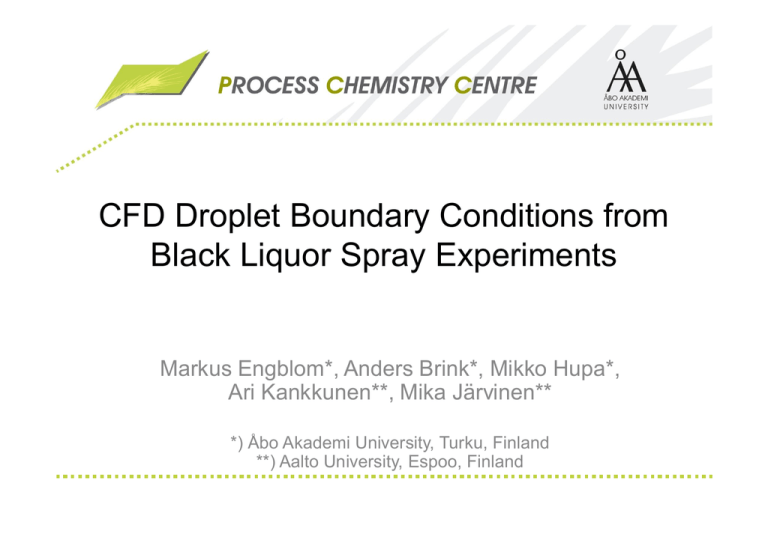CFD Droplet Boundary Conditions from Black Liquor Spray Experiments
advertisement

CFD Droplet Boundary Conditions from Black Liquor Spray Experiments Markus Engblom*, Anders Brink*, Mikko Hupa*, Ari Kankkunen**, Mika Järvinen** *) Åbo Akademi University, Turku, Finland **) Aalto University, Espoo, Finland Black liquor • Kraft chemical pulping Fibers Fibers Lignin etc. + Wood (Honghi Tran) Pulping chemicals (Na2S, NaOH) 155°C 900 kPa Black liquor Black liquor recovery boiler • Recovery of chemicals and heat • Wood • Chemicals • Water Recovered chemicals Heat Chemical pulping Fibers Black liquor • Organic matter • Spent chemicals • Water Recovery processes • Recovery Boiler • Black liquor is burned Black liquor combustion – recovery boiler • Black liquor spray • In-flight combustion Kankkunen et al ~60 m • Char bed • Material input by droplets • Char bed burning ~12 m Black liquor spraying (Rick Wessel) Black Liquor Black liquor spraying CFD simulation input data Initial droplet density - Droplet boundary condition - Currently unknown BL density e.g. 1466 kg/m3 Droplet density ? kg/m3 • Flashing conditions • Experimental data/model not available Initial droplet density important CFD input Initial droplet density (kg/m3) (°C) 430 140 20 Aalto university spray characterization • To obtain initial data for CFD • Special arrangement for video recording liquor spray Droplet tranparency suggest low density For images at > 2m, black liquor spayed along the wall Droplets 2.3 m from the spray nozzle A. Kankkunen 78 mm 10 mm Objectives • Better understanding of liquor spraying experiments • Initial droplet density for CFD Modeling - Spraying geometry Gas velocity (m/s) View from above Spraying along the wall Wall Selected and terminated droplet trajectories Gun opening Wall Wall Gun opening Cross flow – furnace gas Gas BC: - velocity (varied) - temperature 1200°C - non-reactive Wall Gun orientation Gun opening and liquor gun Liquor spray model Gas: - Turbulent flow (k- ) Droplets: - Discrete Phase Model (DPM) - Järvinen/Mueller droplet model - Turbulent dispersion Gas-Droplet interaction: - Heat, mass, and momentum exchange Droplet-Droplet interaction: - Not considered Liquor spray model parameters (1/3) Based on data from spray experiments (Kankkunen et al.) • Opening angles - horizontal 120° - vertical 14° • Size distribution - Rosin-Rammler - Dave = 17.6 mm (after in-flight swelling) - spread 1.93 • Drop sphericity 0.96 (aspect ratio 1.71) • Liquor feed - 5.8 liters/s - 1466 kg/m3 - T = 142 °C - Tboilling = 122 °C • Initial drop velocity: 17.4 m/s Liquor spray model parameters (2/3) Mass flow distribution over opening angles (Miikkulainen et al.) • No mass flow distribution data available for these experiments • Linear distribution assumed – spray chamber data Model assumption Spray chamber data Liquor spray model parameters (3/3) 4.1 m/s 1466 kg/m3 Liquor in-gun swelling 17.4 m/s 345 kg/m3 Droplet in-flight swelling (=simulation cases) - 1.5 m ( 0.086 s) (based on Järvinen) - to density (kg/m3) 345 (all remaining steam to gas phase) 120 58 32 20 (all remaining steam retained in drop) Järvinen: Predicted bubble growth within droplet assuming all steam retained in droplet -0.5 0 0.5 1.0 1.5 Axial distance (m) 2.0 Results - Steam Vs. Droplets Gas velocity (m/s) Steam only With droplets View from above spray Gas flow and nearby wall Gas velocity (m/s) Wall ”Coanda effect” Spray center line The Coanda effect - Impact of cross flow velocity Gas velocity (m/s) Cross flow velocity 1 m/s Cross flow velocity 7 m/s Small Vs. Large droplets 17.6 mm drops 2 mm drops • At low cross flow Segregation of large and small drops Spray spreading Cross flow 1 m/s Cross flow 7 m/s Droplet segregation – Predicted Vs. Experimental Experimental: Droplets smaller on wall side Far from wall 17.6 mm drops Cross flow:1 m/s 2 mm drops Center (Kankkunen et al.) Wall side Spray spreading – Predicted Vs. Experimental 24° Experimental: (Kankkunen et al.) - near nozzle 14° - 2.3 m from nozzle 26° 14° 17.6 mm drops Cross flow:1 m/s 2 mm drops Droplet density Experimental drop velocities (Kankkunen et al.) • Which modeled initial droplet density gives measured droplet velocity behavior at 2.3 from nozzle? Scatter Droplet density • Large-droplet velocities by tracking individual droplets • Within exp. range when 20-80 kg/m3 18 Drop velocity (m/s) at 2.3 m from nozzle 17 Legend: Swell time_drop size _cross flow 16 90ms_10mm_1m/s 90ms_10mm_4m/s 15 90ms_10mm_7m/s Exp. large drop velocity range 14 90ms_18mm_1m/s 90ms_18mm_4m/s 90ms_18mm_7m/s 180ms_10mm_4m/s 180ms_18mm_4m/s 13 density_low density_high 12 11 0 100 200 300 Drop density (kg/m3) 400 Conclusions • Modeling New insight into BL spray experiments • The Coanda effect – proposed contributor to experimentally observed segregation of small and large droplets and spray spreading • Initial droplet density for CFD: 20-80 kg/m3 Acknowledgements This work has been carried out within FUSEC (2011-2014) as part of the activities of the Åbo Akademi Process Chemistry Centre. Other research partners are VTT, Lappeenranta University of Technology, Aalto University and Tampere University of Technology. Support from the National Technology Agency of Finland (Tekes), Andritz Oy, Metso Power Oy, Foster Wheeler Energia Oy, UPM-Kymmene Oyj, Clyde Bergemann GmbH, International Paper Inc. and Top Analytica Oy Ab is gratefully acknowledged.





